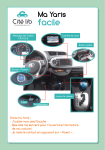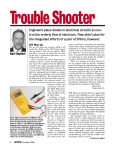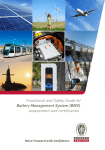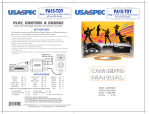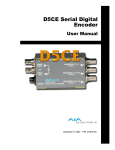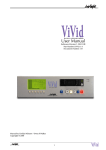Download Dan Marinucci Almost nothing escapes detection by current engine
Transcript
Foreign Service Almost nothing escapes detection by current engine management computers. A seemingly innocuous ‘startability’ trouble code on some late-model Toyota vehicles may warn of future problems. Dan Marinucci [email protected] I ndependence Day comes in July and many people think “the Fourth” just isn’t complete without a fabulous fireworks display. Of course, fireworks occur in automotive repair shops, too. Spilled fuel may catch fire or a live circuit may ground out somewhere. But the worst kind may be those emotional fireworks fueled by the frustration of an unsolved problem. This month’s column concerns one such incident when an odd trouble code appeared on a Toyota. Here’s what we learned. My colleague Matt has a shop up in the northern tier of New York State. He’s been working hard to gather all the routine, manufacturer-mandated maintenance work possible. Obviously, a consistent log of mainte- nance appointments is very beneficial today. The owner of a 2011 Toyota Yaris is among the maintenance customers Matt’s shop attracted. Last winter, this Yaris happened to sit unused for a week and a half. The owner’s wife had become sick and he stayed home to take care of her. But after 10 days, he finally had to run errands again. Fortunately, the car’s battery had some life left in it. But understandably, cranking speed was very slow. Luckily for him, the engine finally fired up after several tries. It spewed some black exhaust smoke and initially ran “as if the choke was stuck on,” he noted. (We can guess this fellow’s age by the fact that he remembered the symptoms of a stuck choke!) Prior to this incident, the car had been Photo: Dan Marinucci continued on page 18 A weak battery and the resulting slow cranking speed can cause DTC P1604 to set on some late-model Toyota vehicles. This code is a relatively new one on Toyota engine control systems. 16 July 2013 Foreign Service running well. According to Matt’s records, the car had 17,000 miles on it and he had done all the recommended maintenance. No trouble codes were present or pending during the car’s last service. However, the Check Engine light came on after the fellow finally restarted the car on that brutally cold morning. Then, much to Matt’s dismay, he took it to the Toyota dealer first for an evaluation. Later, the man had second thoughts about the dealer’s response and drove it to Matt’s shop. Interestingly, no one at the dealership had cleared the code. DENSO 1/2 PG ISLAND 4C 18 July 2013 According to the Yaris owner, the dealer’s service personnel said the Check Engine light and trouble code (DTC P1604) were typical reactions to the hard-starting condition. Their conclusion was that the situation was normal—especially since no other codes were present or pending. One of Matt’s techs scanned the Yaris, verifying that the P1604 was the only code stored. Unfortunately, the lad jumped the gun and cleared the DTC without recording its freeze frame data. So the basic history of the event was lost. However, Matt has followed up with the Yaris owner since then. The car has been running like a top; no additional trouble codes or symptoms have occurred. Start Now or Else! Okay, let’s look more closely at DTC P1604. This is a relatively new code on Toyota vehicles; it’s been in service for only a few model years. Because the service manual dubs it a “startability” code, we’ll begin with the STA (start) signal. If you turn the ignition switch to the Start position on a typical Toyota product, the ignition switch applies battery voltage to the ECM’s STA terminal. Whenever the ECM measures battery voltage at terminal STA, it knows the driver is trying to crank the engine. The start signal (STA), coolant temperature and engine speed could combine to trigger DTC P1604. According to the service manual, two sets of conditions can set this code. The first is when the start signal is on and engine speed remains below 500 rpm an abnormally long time at a given coolant temperature. So suppose the ECM reads battery voltage at terminal STA. It thinks the driver is trying to start the engine. The moment the computer sees the start signal, it compares rpm to coolant temperature; the ECM expects the engine to exceed 500 rpm within so many seconds at a particular temperature. It stores P1604 if it senses a start signal and the engine doesn’t exceed 500 rpm within the proper time at a specified coolant temperature. The colder the coolant temperature, the longer the “starting” time the ECM allows. To give you some idea of the time frame involved here, I referred to a Toyota chart comparing start time to engine coolant. At a coolant temperature of approximately 28°F, the chart indicated the engine should reach 500 rpm in 2 seconds. Therefore, the basic problems—or combination of them—that reduce cranking speed are going to be the likely causes of a P1604 code. In the case of Matt’s customer, for instance, it was a combination of brutal cold, an unused vehicle and a weak battery. The second situation for a startability code is when the engine starts up but then either stumbles badly or stalls. Suppose, for instance, that the engine exceeds 500 rpm and starts up. But then rpm drops to 200 rpm or less within about 2 seconds after start-up. In that case, the computer stores P1604. To put it another way, the ECM is watching for engine speed to drop too much, too abruptly right after start-up. In this scenario, then, your focus is not an abnormally long crank time. Instead, it’s a start & stall or start & stumble diagnosis. ty code. Understandably, the service manual emphasizes that you should always diagnose and correct the causes of the other codes first! Ignoring them is nearly sure to cause a recurring P1604. So all things considered, this new code is likely to route us right back to testing the basics. Talk about fundamentals! Meantime, up in the northern tier, Matt hopes it’ll be warm enough to swim by the time they unload the fireworks. Don’t you think this gentleman needs a heated pool? Just don’t tell him I suggested that expenditure. DENSO 1/2 PG ISLAND 4C Fix Fundamentals First If a P1604 code occurs, by all means record the freeze frame data and study it for clues—especially coolant temperature and battery voltage. Sometimes, you may need to do what you’ve done on other diagnoses: Recreate the same conditions as those cited on the freeze frame. If the startability code is the only one stored, diagnose and repair the fundamentals. Then clear the code and the vehicle ought to be fine. Watch out for a code or codes that appear along with P1604. Basically, the cause(s) of the other code or codes set the stage—created the conditions—that triggered the startabili- July 2013 19



